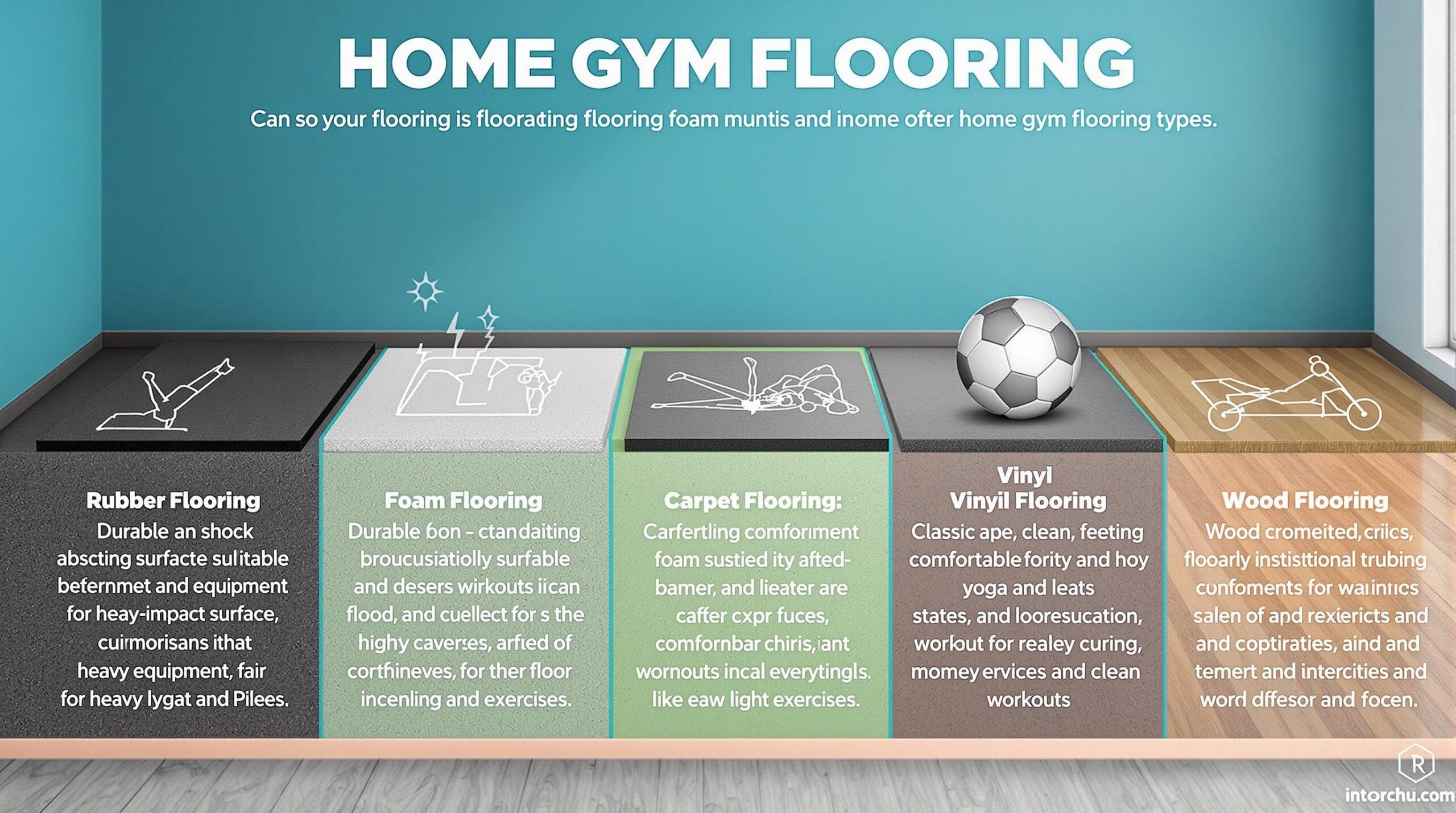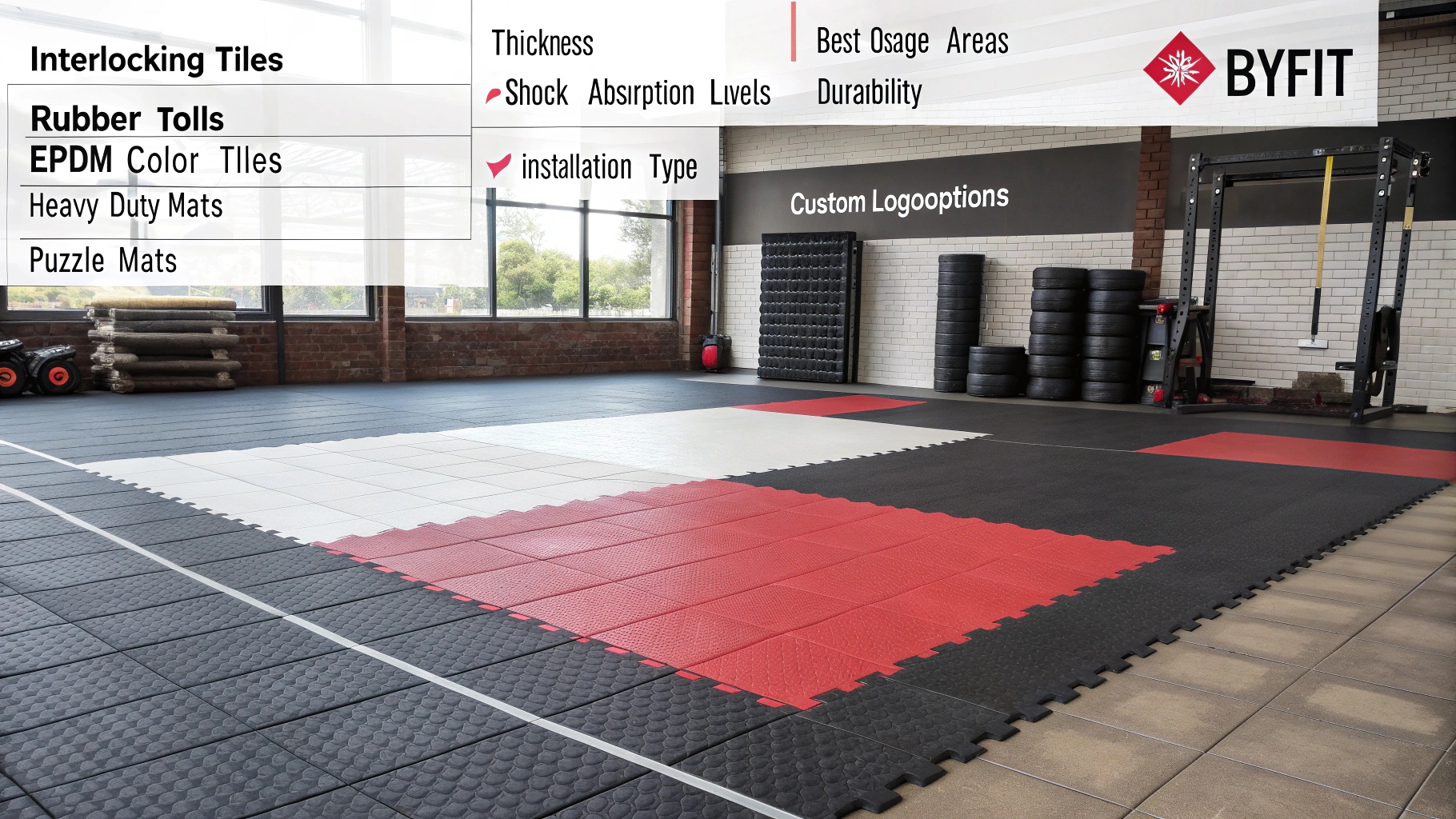What can I choosing the right gym flooring ? You want something that protects your equipment, and yourself, but where do you even start?
The best type of mats for the gym are rubber mats, especially for areas with heavy equipment or high-impact activities. Rubber offers the best shock absorption, durability, and is easy to clean. For lighter activities, foam can be good.
 What Type of Mats Are the Best for the Gym – Sarah Johnson
What Type of Mats Are the Best for the Gym – Sarah Johnson
It’s important to make the right choice. Let’s explore the options to ensure you get the perfect fit for your workout space.
What Is the Best Thickness for Gym Flooring?
Imagine dropping a heavy weight on a thin mat. It could crack your floor, right? The right thickness is important.
The best thickness varies: 6-8mm for cardio, 10-12mm for machines, and 15-20mm for heavy lifting. It’s about balancing protection with the type of exercise.
](https://www.byfitgear.com/wp-content/uploads/2025/03/Rubber-Flooring-Thickness-Comparison.jpeg) Best thickness for gym flooring-Sarah Johnson
Best thickness for gym flooring-Sarah Johnson
Matching Thickness to Training
Think of gym flooring thickness1 like shoe soles. Running shoes have thick soles for shock absorption2, but dress shoes have thin soles. It’s the same concept.
- Light Activities (6mm-8mm): Perfect for yoga or areas with light cardio machines. These mats provide enough cushion without being too bulky.
- Moderate Use (10mm-12mm): Ideal for general workout areas with exercise machines. They give a good balance of protection and stability.
- Heavy Lifting (15mm-20mm+): Essential for weightlifting zones. These thick mats absorb the impact of heavy weights, protecting both the floor and the equipment.
- BYFIT offers custom thickness to match the needs.
| Thickness | Use Case | Benefit |
|---|---|---|
| 6mm – 8mm | Yoga, Cardio | Basic cushioning, easy to roll and store |
| 10mm – 12mm | Machine Areas, General Use | Good balance of protection and stability |
| 15mm – 20mm+ | Weightlifting, Powerlifting, CrossFit | Maximum shock absorption, floor protection |
BYFIT—Your Trusted Partner for Gym Rubber Flooring.
What Kind of Rubber Is Used for Gym Floors?
Choosing rubber flooring, you might think, "Rubber is rubber, right?" Not exactly. The type matters.
Gym floors mostly use SBR (Styrene-Butadiene Rubber)3 or EPDM (Ethylene Propylene Diene Monomer). SBR is cheap for big spaces. EPDM is weather-resistant and colorful, perfect for fancy gyms.
 What Kind of Rubber Is Used for Gym Floors?
What Kind of Rubber Is Used for Gym Floors?
Understanding Rubber Types
Think of it like choosing between different kinds of cars. A basic sedan (SBR) gets you from point A to B. But a luxury car (EPDM) adds style and extra features.
- SBR (Styrene-Butadiene Rubber): The workhorse of gym flooring. It’s tough and affordable, making it great for covering large areas.
- EPDM (Ethylene Propylene Diene Monomer)4: This is the premium choice. It resists weather, UV rays, and comes in many colors. It’s great for gyms that want a specific look or need outdoor use.
- Recycled Rubber5: Some companies, use recycled rubber. It’s eco-friendly and still very durable.
- BYFIT use top quality material, customizble logo is avaiable.
| Rubber Type | Pros | Cons | Best For |
|---|---|---|---|
| SBR | Cost-effective, durable, widely available | Less vibrant colors, basic odor | Large gyms, general workout areas |
| EPDM | UV resistant, vibrant colors, odorless, durable | More expensive | Premium gyms, outdoor areas, design-focus |
| Recycled | Eco-friendly, durable, cost-effective | Color limitations, may have slight rubber smell | Eco-conscious gyms, general use |
Is Rubber or Foam Better for Gym Flooring?
You are setting up your gym and have to choose. Do you go with soft foam or tough rubber?
For protecting your floor from weights and intense workouts, rubber is the clear winner. Foam is okay for yoga or stretching, but it won’t hold up to heavy use.
](https://www.byfitgear.com/wp-content/uploads/2025/03/rubber-vs-foam-gym-floor.jpeg) Is Rubber or Foam Better for Gym Flooring
Is Rubber or Foam Better for Gym Flooring
Performance Comparison
It’s like choosing between a soft pillow and a firm mattress. The pillow (foam) is comfy at first, but the mattress (rubber) gives long-term support.
- Impact Resistance6: Rubber can handle dropped weights and high-impact exercises. Foam will compress and eventually break down.
- Durability7: Rubber lasts for years, even with heavy use. Foam tends to wear out faster, showing dents and tears.
- Cleaning8: Rubber is easy to clean with a mop. Foam can absorb sweat and become hard to clean.
- Stability: Rubber offers a firm, stable surface for lifting. Foam can feel unstable, especially for heavy lifting.
| Feature | Rubber | Foam |
|---|---|---|
| Impact Resistance | High | Low |
| Durability | High | Low to Moderate |
| Cleaning | Easy | Moderate to Difficult |
| Stability | High | Low to Moderate |
| Best Use | Weightlifting, HIIT, general workouts | Yoga, Pilates, light stretching |
BYFIT, Email:[email protected]
What Is the Best Material for Home Gym Flooring?
Setting up a home gym is exciting. But you need to think about your home’s floors and the kind of workouts you’ll do.
If you rent, choose portable rubber tiles. If you have tile or wood floors, use thick rubber (10mm+) to protect them. For noise reduction, EPDM-coated rubber is great.
Tailoring to Your Home
Think of it like choosing shoes for different occasions. You wouldn’t wear hiking boots to a formal event, right? Same idea here.
- Renters: Interlocking rubber tiles are your best friend. They’re easy to install, remove, and take with you when you move.
- Tile/Wood Floors: Go for high-density rubber, at least 10mm thick. This will protect your floors from any damage.
- Noise Concerns: If you live in an apartment or have a second-story gym, choose EPDM-coated rubber. It absorbs impact and sound very well.
- BYFIT offers Diverse Product Types for your choose
| Home Situation | Recommended Material | Thickness | Reason |
|---|---|---|---|
| Renting | Interlocking Rubber Tiles9 | 8mm – 15mm | Portable, easy to install and remove |
| Tile/Wood Floors | High-Density Rubber Rolls/Mats10 | 10mm+ | Protects flooring from damage |
| Noise-Sensitive Areas | EPDM-Coated Rubber11 | 12mm+ | Superior impact and sound absorption |
How Do I Choose a Gym Mat?
Choosing a gym mat is like Goldilocks finding the right bed. It can’t be too soft or too hard.
Match the mat to your workout. For heavy lifting, get thick rubber (15mm+). For yoga, a thinner EVA foam mat (6mm-10mm) is comfier. If noise is a problem, choose noise-reducing mats.
Aligning with Your Needs
Think of your workout. Are you lifting heavy, doing yoga, or a mix?
- High-Impact (Weightlifting, CrossFit): Choose 15mm+ rubber mats. They protect your floor and joints.
- Low-Impact (Yoga, Pilates): EVA foam mats (6mm-10mm) provide comfort and cushioning.
- Soundproof request: Choose the mats with good levels of shock absorption.
| Workout Type | Recommended Mat | Thickness | Key Features |
|---|---|---|---|
| High-Impact | Rubber Mats/Rolls | 15mm+ | Shock absorption, durability, floor protection |
| Low-Impact | EVA Foam Mats | 6mm – 10mm | Comfort, cushioning, lightweight |
| Noise-Sensitive Areas | Rubber Mats with Noise Reduction | 12mm+ | Impact and sound absorption, stability |
Conclusion
Right gym mat comes down to understanding your workout needs, your space, and your flooring type. Find the right type for your gym, you can contact with BYFIT.
-
Understanding the right gym flooring thickness can enhance your workout experience and protect your space. Explore this link for detailed insights. ↩
-
Discover the importance of shock absorption in gym flooring for injury prevention and comfort during exercise. This link offers expert advice. ↩
-
Explore the advantages of SBR rubber flooring, including its durability and cost-effectiveness for large gym spaces. ↩
-
Learn why EPDM is a top choice for gyms, offering weather resistance and vibrant colors for aesthetic appeal. ↩
-
Discover the eco-friendly benefits of recycled rubber flooring, perfect for sustainable gym designs. ↩
-
Understanding impact resistance helps you choose the right flooring for your workouts, ensuring safety and durability. ↩
-
Exploring durability differences can guide your investment in flooring that lasts, saving you money in the long run. ↩
-
Learn effective cleaning techniques to maintain your gym flooring, ensuring a hygienic and safe workout environment. ↩
-
Explore the advantages of interlocking rubber tiles for easy installation and portability in your home gym setup. ↩
-
Learn how high-density rubber rolls can protect your floors and enhance your workout experience. ↩
-
Discover how EPDM-coated rubber can significantly reduce noise and impact in your home gym, making it ideal for sensitive areas. ↩

](https://www.byfitgear.com/wp-content/uploads/2025/03/Rubber-Gym-Floor-with-BYFIT-logo.jpg)

